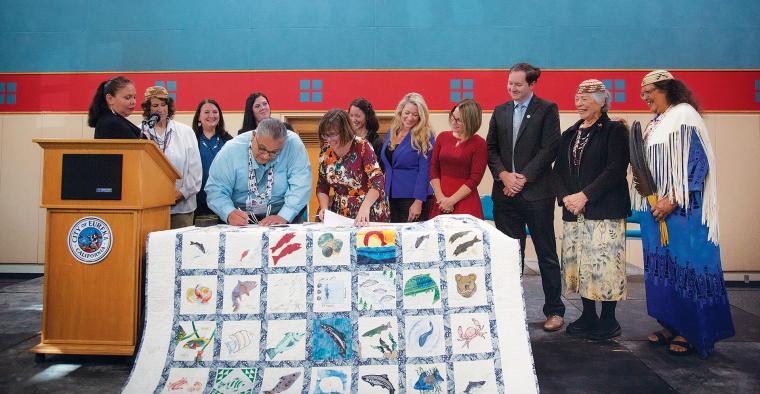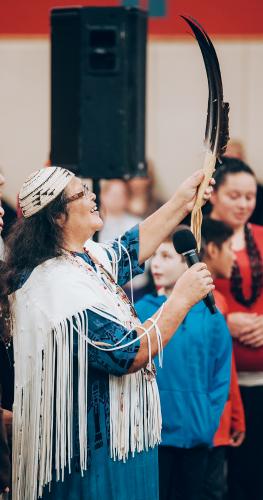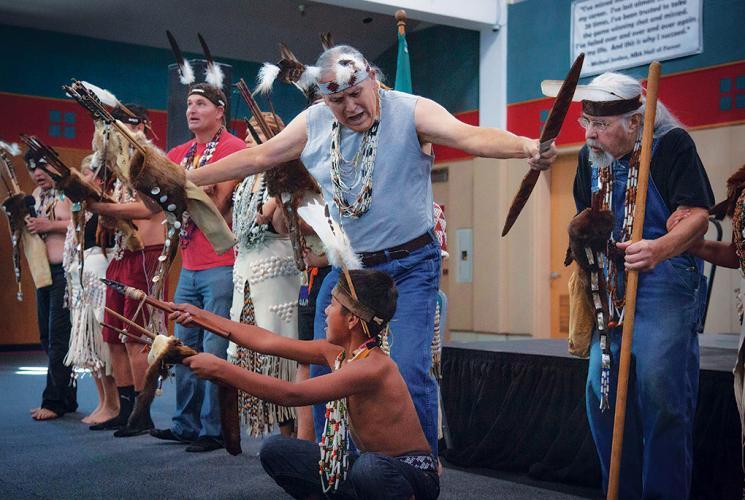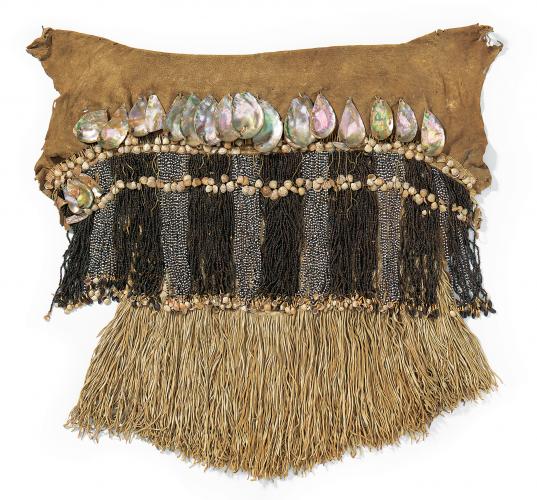The low-lying island in the middle of Humboldt Bay off the fog-shrouded redwood coast of Northern California is about a mile long and half as wide. Much of it is salt marsh that is frequently washed over by 6-foot tides. The high ground at the island’s north end, marked by a small building and lone Acacia tree, and the elevated lands south of the bridge that divides the island were formed by mounds of clamshells discarded over centuries by members of the Wiyot Tribe. Here, their villages of Tuluwat and Etpidolh once thrived. Then in 1860, during the Wiyot’s spring World Renewal Ceremony, white vigilantes invaded the island, killing many of its inhabitants.
This past October, the City of Eureka returned the island to the Wiyot people. Although in 2014 the Wiyot Tribe was able to complete the World Renewal Ceremony that was cut short by the massacre, this March, they will be holding this sacred ceremony on their own island. The land, which has long been known as Indian Island, will now be called by the Wiyot name, Tuluwat Island. This unconditional return of land by a U.S. city to its original Native owners is a historic opportunity for both the tribe and the island to heal.
Pain and Theft
Violence and efforts to destroy Wiyot culture have long traumatized but never defined the Wiyot people. They have lived on the island and other lands around Humboldt Bay since “time immemorial,” says Cheryl Seidner, former Wiyot tribal chair and cultural liaison. Their creation story tells that the island is not just their ancestral homeland but the center of the world. “The island is not sacred because people were killed there,” she says. “It’s sacred because that is where we come from.”
The first American settlers arrived in Humboldt Bay in 1850. Ten years later, on the night of February 26, a death squad called the Humboldt Volunteers attacked the Wiyot in the midst of their weeklong renewal ceremony while the able-bodied Wiyot men were away gathering supplies. The attackers used mostly hatchets, clubs and knives so residents of the nearby town of Eureka wouldn’t hear a lot of gunfire. Some 200 women, children and elders were killed. Within days, more than 100 additional people were murdered on other Wiyot lands at the southern end of the bay.
While the tribe had coexisted peacefully with the white settlers, the excuse given for the attack was that some cattle had allegedly been stolen by some unidentified Native people. Earlier in the month of the massacre, dairyman Robert Gunther had procured a U.S. deed to the island, a possible motive for eviction by murder. The island soon became known as Gunther Island. He diked and attempted to drain the land so he could graze cattle there. An 1870s shipyard and later a sawmill left a legacy of ground and water pollution.
No one was ever prosecuted for the mass murders of 1860. Instead, many Wiyot who sought refuge at the local army fort died of exposure and starvation. White settlers also tried to extinguish their culture. U.S. government officials removed some Wiyot children from their families and placed them into residential boarding schools, where they were forbidden to speak their language and taught “American culture.” What happened to the Wiyot and other California tribes during the Gold Rush Era fits the United Nations definition of genocide: actions intended “to destroy, in whole or in part, a national, ethnical, racial or religious group.” In 1850, an estimated 1,500 to 2,000 Wiyot people lived around Humboldt Bay. By the 1900 census, only 100 Wiyot were left. Yet their culture lives on.
A Singing Dress
The Wiyot’s Table Bluff Reservation is located near the coast, 15 miles south of Tuluwat Island. At the tribe’s Cultural Heritage Center this past December, Michelle Hernandez- Wenzler, aided by cultural assistant Hazel James, carefully held up her Coming-of-Age Dress made of deerskin. It’s covered with shells and seeds that “sing” as the skirt moves during a dance. Hernandez-Wenzler wore this traditional dress in 2006 during her coming-of-age ceremony, the Wiyot’s first such ceremony in 150 years.
The daughter of Tribal Chair Ted Hernandez, Hernandez-Wenzler says, “I’m Wiyot but also Latino, so at 14, my folks asked if I wanted a Quinceañera (a 15th-birthday celebration for Latina girls) or a Sweet 16 party. But I didn’t like the poofy dresses, so I asked, ‘What did we do?’ I went to the elders and asked them and other tribes who have similar coming-of-age ceremonies,” she recalls. “We made the dress and worked picking leaves and seeds. It took a year to get the periwinkles and pine nuts and drill the shells, and everyone from my grandmother to my little sister, who was 9, was helping.”
Her ceremony lasted three days. “I had to fast for three days, drinking nothing but acorn water. It was really cold where I had to go into the bay to cleanse myself. The dress was really heavy, and I had to dance for two to three hours on my toes,” she says while demonstrating a hopping motion with her feet. “I had to build endurance, and when I have challenges in my life now, I know I can deal with them because I did then. I danced with a blue jay feather, kind of blocking my vision, and when my parents removed the feather, then I could see the world as a young woman, no longer as a child,” she smiles wistfully.
“It was kind of hard on me as a dad to see her shivering in the cold water and wanting to warm her up or just hug her when she was so exhausted,” says Hernandez, “But at the same time, we were bringing back this ceremony. The Hoopa and Yurok and other tribes were there for it. It was pretty amazing.”
“We didn’t have this in my generation, but now the generation of my younger siblings have had them their whole lives,” Hernandez-Wenzler adds. “I won’t say we lost these ceremonies, but they were sleeping, and now they’re awake again.”
Hernandez-Wenzler’s dress is one of three now kept at the cultural center, with three more in the process of being brought to life for the young women of the tribe. She patterned her dress, now known as the Granddaughter Dress, after a 140-year-old one named the Grandmother Dress that is in the care of the National Museum of the American Indian’s Cultural Resources Center (CRC) in Suitland, Maryland.
Her design was largely based on notes and drawings Cheryl Seidner made when she visited the CRC about 15 years ago to view the Grandmother Dress. Later, the tribe appealed to NMAI to borrow the dress for the 2014 World Renewal Ceremony.
Susan Heald, NMAI’s textile conservator, was among those at the museum who carefully examined the Grandmother Dress, the oldest of such dresses known to be in existence, to determine if it was strong enough to be danced in. “I’ve examined every strand and detail and all the threads are hand-spun iris fiber from the leaves and are still relatively strong. The whole construction of the dress is complex: hide strips cut to make the fringe, and each end has a little bivalve shell or blackened pine nut, the bear-grass wrapping and thousands of little juniper seeds. There’s so much love put into making this dress. Plus, there’s the sound it makes when being worn by a dancer, shells moving together at the bottom of the dress and the larger [abalone] shells at hip level.”
After determining that the dress would survive the journey and the ceremony, the tribe’s request was granted. Heald then carefully packed and hand-carried the dress to the 2014 ceremony in Humboldt. Heald says, “It was an absolute privilege to be the one to take it there and see the importance of the dress being danced.” Hernandez-Wenzler and two other young women danced in the dress at the ceremony. “It was mesmerizing seeing it come home to dance and sing,” Seidner recalls.
The museum is once again loaning the Grandmother Dress to the Wiyot so that it can be danced at their World Renewal Ceremony this March.
Reclaiming Sacred Ground
One of the few survivors of the 1860 island massacre was Jerry James, who was found as an infant suckling his dead mother’s breast. In the 1970s, his great-grandson Albert James, Albert’s wife, Beverly, and Loreta Seidner began campaigning for Wiyot rights, including the return of the island, reinstatement of the tribe’s legal status (which had been terminated by the government but was restored in 1981) and establishment of the present Table Bluff Reservation, where about a third of the tribe’s 645 members live today.
Others joined the James family in these early efforts, including Cheryl Seidner and her sister, Leona, both of whom worked at nearby Humboldt State University. In 1992 the two sisters and two other women, a local minister and the head of the Humboldt County Historical Society, led a vigil on Woodley Island, just across from the island. The vigil grew into an annual commemoration of the 1860 massacres and demand for the island’s return.
In 2000, after one year of fundraising that also mobilized the larger Eureka community, the tribe was able to purchase 1.5 acres of land at the northern end of the island. Unfortunately, by that time the property had become a toxic wasteland.
“The boatyard and sawmill left an environmental disaster, with scrap metal and hazardous liquids of unknown origin. There was even a seawall made of old marine 12-volt boat batteries leaking chemicals into the bay,” recalls Tribal Administrator Michelle Vassel. “We had all these volunteers working on things like hauling out wood debris and metal projectiles. You could cut yourself just trying to walk around.”
Over the years, tribal members and other volunteers have removed all sorts of debris from the island, including bulky engines and containers of paint. They filled barges with more than 60 tons of iron and steel. They had to take down two decrepit buildings and a water tower, but they were able to save a smaller building for future use.
The tribe, with volunteers from religious institutions and environmental groups, also began restoring the salt marsh by removing invasive plants, including spartina or cordgrass that has overwhelmed parts of the bay. This allowed for the return of highly productive eelgrass beds and other native plants, including coyote brush, Humboldt Bay owl’s clover, elderberry and salmonberry. “As soon as we took out the spartina, the native plants and animals, they all just bloomed,” Vassel recalls. “And everyone eats out of this bay. We were helping oyster farms and commercial fishermen, too.”
Partly in recognition of the cleanup, the city returned 40 acres of adjacent land to the Wiyot people in 2004. Still, the conservation effort was far from over. “We had contractors working in hazmat suits treating and removing contaminated soil,” Vassel says. With U.S. Environmental Protection Agency funding, they were able to complete the cleanup and the agency certified the site clean in 2013. Only then was the tribe able to complete their 1860 World Renewal Ceremony in 2014.
The Right Thing to Do
In December 2018, the Eureka City Council voted to relinquish the deed to their remaining 202 acres on the island, turning it over to the Wiyot people—an action that, with few exceptions, had widespread support throughout the community.
Eureka Mayor Susan Seaman recalls the council meeting that preceded the official transfer on October 21, 2019. It started with comments from five council members who then quickly voted unanimously to return the island. “The council meeting was maybe 10 minutes. After that, we turned it over to the tribe for their Welcome Home ceremony that had dancing and presentations. I didn’t expect to, but I cried because there was just so much joy in that room.”
With that decision, leaders of the Wiyot Tribe and Eureka officials believe this municipality of just 27,000 people became the first city in the United States to unconditionally return land to its original owners. “I heard we were the first, but first or not, it was just the right thing to do,” says City Council Member Kim Bergel, who, along with fellow Council Member Natalie Arroyo and former Mayor Frank Jager, played a crucial role in the transfer. “I was born and raised here, fourth generation in Humboldt. Every third-grader takes a tour of the bay and is told the history of what happened,” she says. “I got older and learned more of what had taken place, where they used hatchets on babies. And you think, ‘Who does that?’ Giving the island back can’t take away what happened, but it is a step in the right direction. It’s always important to make amends.”
“I was surprised when I heard we got it with no strings attached,” says Seidner, who blessed the transfer ceremony with a Wiyot prayer. “When I heard that I was pleasantly happy. I never thought I’d see this in my lifetime.”
A Working Future
A few private houses are still located at the south end of the island, but Tribal Chair Ted Hernandez says the Wiyots have no plans to disturb their owners. “We know what it’s like to be removed from your home,” he says. “My goal is to put a new cultural and youth center in Eureka by the water, looking across at the island.” He hopes to dedicate the center within two years, a project Mayor Seaman fully supports. Hernandez thinks the center will provide an opportunity to connect a new generation of Wiyot youth to Tuluwat Island.
Soon after the Grandmother Dress was loaned to the tribe for the 2014 ceremony, the Wiyot people requested it be repatriated, or restored permanently, to the tribe. The claim is under review. Hernandez’s daughter Michelle would like to see the dress return home. “It needs to be with us to sing and dance, and because it needs to be with its Granddaughter Dress,” she says. “The dress represents cultural continuity and is a sign of resiliency.”
Tribal Administrator Michelle Vassel also has plans. This past December, she took a boat trip to the island with Wiyot Department of Natural Resources Director Eddie Katz and City Council Member Bergel. On this calm day, the bay’s mirrorlike surface reflected a cerulean sky and chalk-white cumulus clouds. Visible were seagulls, wading shorebirds, a pelican, a loon, a white-tailed kite, plus many egrets and great blue herons, which stood like sentinels along the reedy shore. Vassel showed a cellphone video she took two days earlier of a buck mule deer swimming from Tuluwat over to nearby Woodley Island in the rain.
“We will continue our native plant restoration and cultural restoration on the island,” she promises. “Our next step will be doing this on the other side of the island [south of the highway bridge].”
“This story tells you that you can change history and turn back the times,” she reflects, searching the mudflats for her favorite island creatures, baby crabs. “I’ve seen this all happen in my lifetime. But it doesn’t happen just because it’s right. It takes a lot of people working over time.”
Editor's update: After this issue went to press, the coronavirus forced the Wiyot Tribe to postpone their World Renewal Ceremony, which was originally scheduled for March.






